Uniting for growth: Scaling NABERS’ reach and influence in FY24
NABERS continues to drive transformative growth and collaborative innovation, opening the door to diverse sectors and expanding our reach.
Highlights from this year include:
- 5,000 ratings certified in FY24, with 97% achieved within 10 days of submission
- 73% increase in the number of hotels with NABERS Energy and Water ratings
- 110% increase in the number of hotels with NABERS Energy ratings of 5 stars or above
- 15% increase in NABERS Energy and Water for Shopping Centre ratings
- 150% growth in residential aged care and retirement living NABERS Energy and Water ratings
- 125% increase in the number of apartments with NABERS Energy ratings of 5 stars or above
- 133 Victorian public hospitals rated for the first time in the 2024 NABERS Sustainable Portfolio Index
- 700-plus attendees at NABERS’ biggest ever conference
- 3 new NABERS rating tools for schools, retail stores and Energy Performance Indicator, alongside the NABERS Embodied Carbon pilot 25-year celebrations of NABERS enabling the design, construction and operation of more sustainable buildings.
Over the past two decades, NABERS has helped customers save:
- $1.96 billion in energy bills and
- 13.41 million tonnes of CO2 emissions.
To see more on the evolution of NABERS over the past two decades, see the Life of Program Statistics.
NABERS + CBD Conference builds momentum
“Building Momentum for a Sustainable Future” wasn’t just the theme of the largest NABERS + CBD Conference in June 2024 – it was a promise delivered with every session, conversation and connection.
Almost 400 people gathered on Gadigal Country, with another 300 joining virtually, to hear about NABERS' progress and future plans.
Opening the conference, federal Assistant Minister for Climate Change, Jenny McAllister, hailed NABERS’ achievements over 25 years as “nothing short of world-leading”.
Anthony Lean, Secretary of the NSW Government’s Department of Climate Change, Energy, the Environment and Water, noted that Australia’s 13 years of leadership in GRESB, the global real estate sustainability benchmark, is “because investors, owners and tenants have embraced NABERS like no other”.
The conference sparked conversations about key topics like electrification, embodied carbon, sustainable finance, circular economy, net zero policy, and featured inspiring success stories that underscored the real-world impact of NABERS ratings.
The response from conference delegates was overwhelmingly positive, with 89% rating the event as “very good” or “excellent”.
Importantly, the conference was the platform for several transformative announcements. These included the Australian Government opening a consultation for the expansion of the Commercial Building Disclosure program, which will require more buildings to disclose their NABERS ratings, and the launch of the pilot phase of the new NABERS Embodied Carbon rating tool.

Image: Anthony Lean – Secretary NSW Department of Climate Change, Energy, the Environment and Water (DCCEEW) opening address at the conference
Below: Images of breakout sessions at the 2024 NABERS + CBD Conference in June 2024.

Image: Mara Putnis (Commonwealth Department of Climate Change, Energy, the Environment and Water), Anne Martinelli (Victoria Department Environment, Land, Water and Planning), Melinda Dewsnap (City of Sydney), Monique Alfris (NABERS)

Image: James Elks (NABERS)

Image: Dr James Goddin (Thinkstep ANZ), Chloe Rose (APCO), Sara Levett (NABERS)

Image: Carlos Flores (NABERS), Francesca Muskovic (Property Council Australia) and Luke Menzel (Energy Efficiency Council)
NABERS celebrates 25 years of gamechangers
The rating program that was to become NABERS, the Australian Building Greenhouse Rating System, was launched in 1999. To mark the 25-year anniversary, we asked a few instrumental people to reflect on the ‘gamechangers’ that transformed Australia’s property market.
We were honoured to capture stories from early government leaders who championed a bold idea, landlords who took a leap of faith, and professionals and practitioners who backed NABERS because they believed in better buildings.
The result is 25 Years of Game Changers, which we launched at the NABERS + CBD Conference. This booklet is a small way of saying ‘thank you’ to the thousands of sustainability champions who have joined forces to save the world, one building at a time.
NABERS 2024-2029 Strategic Plan shapes the future
In June 2024, we released the NABERS Strategic Plan for 2024-2029, shaped by extensive consultation and collaboration with our stakeholders.
The new strategic plan was developed over the course of 18 months. It involved extensive consultation with more than 80 stakeholders through workshops, webinars and surveys.
The NABERS Strategic Plan 2024-2029 sets ambitious targets to amplify NABERS’ positive impact across Australia. It introduces a renewed vision, mission and goals that underscore our commitment to scaling NABERS throughout the Australian built environment.
Vision: Sustainable buildings enable a world where people and the natural environment thrive.
Mission: NABERS collaborates with others to enable the design, construction and operation of more sustainable buildings. Our valued information supports better decisions in pursuit of positive environmental, social and economic outcomes.
The plan also includes three goals that will guide our decision making and work plans:
- Goal 1: Improve performance: All sectors and rating types improve their NABERS performance over time.
- Goal 2: Grow the market: Triple the number of NABERS ratings by driving uptake of existing tools and expanding to new sectors.
- Goal 3: Evolve for impact: Evolve and continuously improve NABERS.
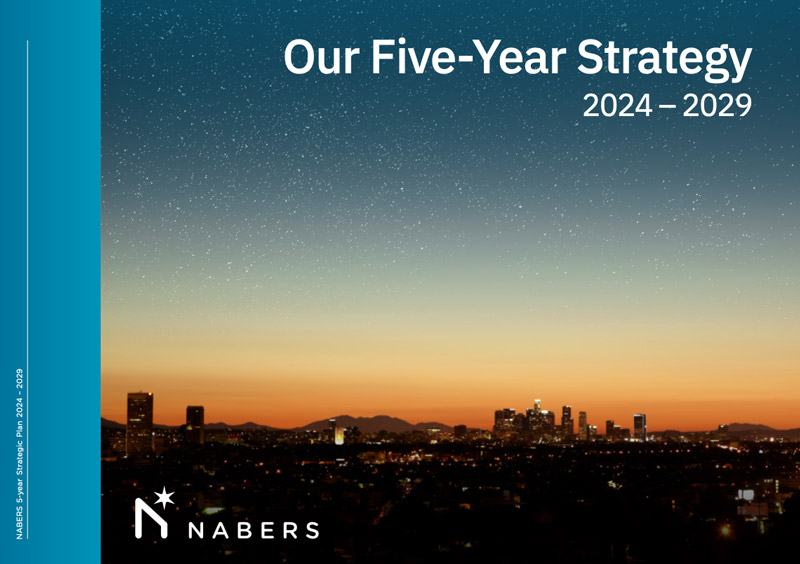
Image: Cover of NABERS Strategic Plan 2024-29
New voices join NABERS Steering Committee
In May 2024, 19 industry organisations were selected to join the NABERS Steering Committee as stakeholder members for a three-year term, following a competitive expression of interest process in 2023.
The cohort includes five new members: Australian Industry Group, Australian Institute of Quantity Surveyors, Engineers Australia, National Retail Association and Supply Chain & Logistics Association of Australia.
Together the 19 organisations, typically peak industry bodies, represent a wide range of NABERS stakeholders across the built environment and the Australian economy.
As a vital part of NABERS’ robust governance, stakeholder members provide invaluable industry insights which contribute to NABERS’ strategic direction and business planning. While these members are non-voting, their contributions are significant, and they actively participate in discussions and provide input into key decisions made by government members of the NABERS Steering Committee.
Sustainability Portfolios Index 2024 showcases leadership
Entering its sixth year in 2024, the NABERS Sustainable Portfolio Index (SPI) ranks portfolios of building assets according to their NABERS ratings for energy efficiency, water efficiency, waste management and indoor environment quality.
The 2024 SPI Office Energy Index includes 417 assets, representing close to 7.4 million sqm of area or 24% of the total national office market. Walker Corporation’s Parramatta Square achieved the highest result of 5.8 stars.
The SPI Office Water Index disclosed ratings for 399 assets, equating to approximately 7.2 million sqm area, or 23% of the total national office market. Lendlease’s Barangaroo International Towers received the highest result, with 6 stars, as well as the highest Indoor Environment rating (5.9 stars).
Cbus Property topped the SPI Office Waste Index, with 4.4 stars. This is the third consecutive year that Cbus Property has led the market in Waste, improving by 0.3 stars each year.
Another standout achievement was the Victorian Health Building Authority’s (VHBA’s) commitment to rate the energy and water efficiency of 133 public hospitals, representing approximately 2.9 million sqm of area and approximately 6.5 million occupied bed-days. VHBA’s overall Energy rating of 4.1 stars represents ‘high performance’, while 13 hospitals achieved 6-star ‘market leading’ NABERS Water ratings.
VHBA’s overall Energy rating of 4.1 stars represents ‘high performance’, while 13 hospitals achieved 6-star ‘market leading’ NABERS Water ratings.
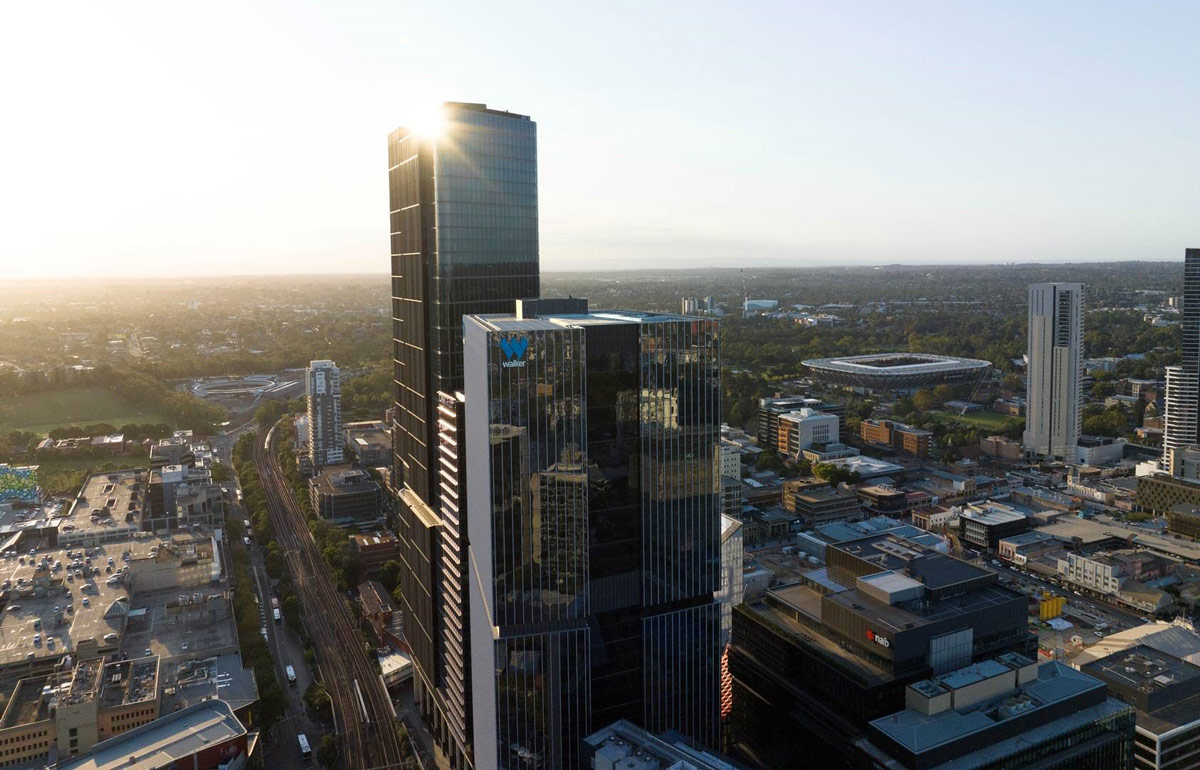
Image: Walker Corporation’s Parramatta Square achieved the highest result in the 2024 Sustainable Portfolios Index of 5.8 stars in Office Energy
Sector Engagement: New sectors and wider reach
NABERS rolled out new rating tools for retail stores and schools, expanded the Energy Starters grants program to data centres, launched the pilot phase for the Embodied Carbon rating tool and enhanced the NABERS Perform platform. We also began work to refresh the NABERS Sustainable Finance Criteria and contributed to the development of the new sustainable finance taxonomy.
NABERS Energy and Water for Schools
Australia is home to over 9,600 schools, and now every one of them can achieve NABERS Energy and Water ratings. In FY24, NABERS worked closely and consulted with government education departments from six Australian states and territories, peak bodies from the Catholic systemic and independent sectors, and individual schools to successfully launch the tool. We trained 130 Assessors and piloted the rating tool with 56 government and non-government schools.
Our extensive collaboration, complemented by data collected from thousands of schools, has delivered a convenient process and central point for portfolio-style ratings. Individual rating certifications are also available.
This year, the NABERS team is partnering with the education departments in NSW and Victoria to rate the first school portfolios. The tool marks a significant step forward in helping the buildings where we educate our young people and future generations to transition towards a net zero future.
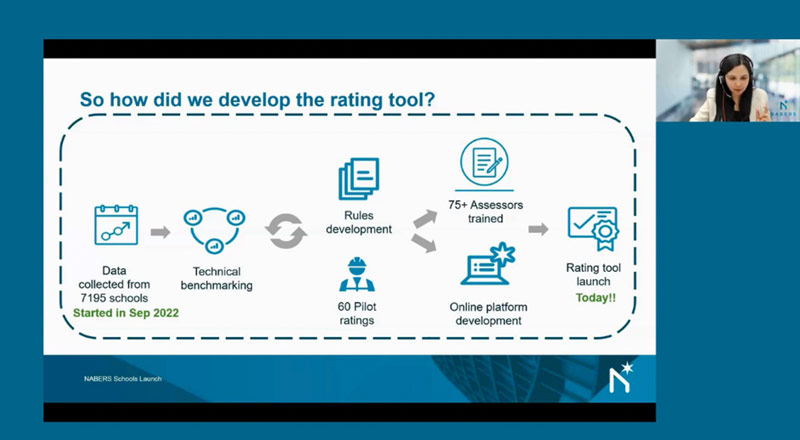
Image: Webinar from the NABERS Schools launch webinar featuring Suruchi Pathak (NABERS)
NABERS has also expanded the scope of the NABERS Commitment Agreement and Agreement to Rate to include schools. We are now engaging with education departments and peak bodies to help schools get started on their sustainability journeys.
NABERS Energy for Retail Stores
The retail sector accounts for more than 16% of Australian building energy. While NABERS has been rating shopping centres since 2010, tens of thousands of individual retail stores were previously outside our scope. After extensive consultation with retailers, peak bodies and industry experts, we have developed a new tool to expand NABERS ratings to these stores.
The robust benchmark is based on data from more than 4,000 diverse retail stores, underscoring the strong collaboration between government and industry. Seventeen retail stores, ranging from large department stores to small clothing shops, participated in pilot ratings, and we’ve trained 100-plus Assessors to support the rollout of this new rating tool.

Image: Officeworks stores at Bundoora, VIC, and Bondi Junction, NSW, were one of the first retail stores to get the NABERS Energy for retail stores pilot rating
The tool covers a wide range of retail stores, including department stores, bank branches, electronics, hair and beauty salons, clothing stores, pharmacies and more. The tool can help rate stores inside shopping centres, on street arcades or standalone, like ‘big box’ retail.
We also started work on NABERS Co-Assess for Shopping Centres, which is set to launch in early 2025. This will allow retail stores to obtain individual NABERS ratings alongside the shopping centre NABERS Energy rating. Building managers, owners and individual businesses will have more tools on hand to better understand their energy consumption and collaborate to improve their performance.
NABERS Embodied Carbon
Today’s construction decisions cement tomorrow’s environmental footprint. As our grid decarbonises and operational emissions decline, embodied carbon is on track to be the largest source of emissions in Australia’s building sector.
With that in mind, we launched the pilot phase of the much-anticipated NABERS Embodied Carbon rating tool in June 2024 at the NABERS + CBD Conference.
Kick-started as part of a $4.8 million investment from the NSW Government, the NABERS Embodied Carbon rating tool has been developed in collaboration with the Green Building Council of Australia (GBCA), Infrastructure Australia and Infrastructure NSW.
NABERS Embodied Carbon aligns with international standards for lifecycle assessment in buildings, and is already being referenced in policy, notably the NSW Sustainable Buildings SEPP and the Australian Government’s Environmentally Sustainable Procurement (ESP) Policy and Reporting Framework.
In June, we also released the national emission factors database for embodied carbon measurement that will serve as a reliable resource for emission factors where product-specific Environmental Product Declarations (EPDs) are unavailable.
NABERS Energy Performance Indicator
In June 2024 we launched the NABERS Energy Performance Indicator, a simplified energy rating process for sectors that do not currently have a standalone NABERS Energy rating tool.
The Energy Performance Indicator is a versatile tool that can be used across various sectors to track and improve energy efficiency. It applies to entertainment and recreation centres and sports facilities like aquatic centres, cinemas and gyms, hospitality venues like bars, restaurants and cafes, public buildings like libraries and museums, transport hubs such as airports and train stations can also use the tool. So can manufacturing and storage sites, childcare centres, caravan parks and more. The development process was informed by deep user research, testing and prototyping. Applying these insights, we developed a new ‘dial’ visual which was rigorously tested to ensure a seamless user experience. We also developed comprehensive training, accreditation and supervision processes, alongside updated NABERS rules, to support the Indicator’s uptake.
Released to the market at the NABERS + CBD Conference, the Indicator has already garnered positive feedback from industry. We look forward to sharing the tool’s progress in FY25.
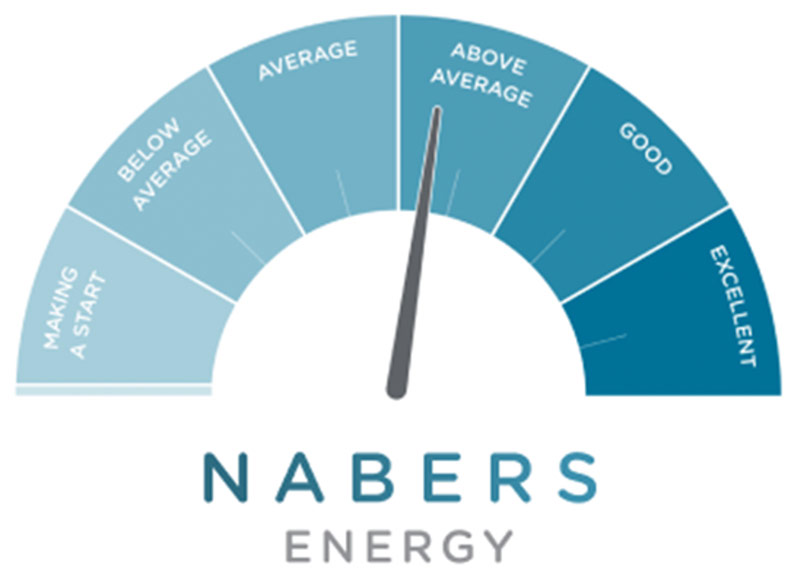
Image: Energy Performance Indicator dial
NABERS Sustainable Finance Criteria
NABERS ratings have a strong reputation for being robust and rigorous which means they are increasingly used as evidence of environmental credentials in sustainable finance transactions. We developed Sustainable Finance Criteria in 2022 to provide guidance on how investors and borrowers can apply NABERS ratings in their transactions.
This year, we undertook a comprehensive review of the NABERS Sustainable Finance Criteria. During the consultation phase, we engaged more than 15 separate stakeholder organisations to ensure we maintain the criteria’s relevance and continue to align with the evolution of green finance in the market. The refreshed criteria documents will now contain NABERS targets for water and waste as well as energy, and they are anticipated to be launched in the 2024/25 financial year.
NABERS is also actively contributing to the sustainable finance taxonomy currently under development by the Australian Sustainable Finance Institute (ASFI), as a member of the ASFI’s built environment working group.
The NABERS team also participated in several sustainable finance panels during the year, including GBCA’s Green Building Day series of events. Discussions in Sydney, Brisbane, Perth, Melbourne and Adelaide explored opportunities to leverage NABERS ratings to secure sustainable finance.
Energy Starters grants program
Supported by the NSW Government, the Energy Starters program helped 56 buildings across a diverse range of sectors to begin their energy efficiency journeys in FY24. Among these, 20% were in regional areas.
Hotels, office tenancies and shopping centres accounted for 88% of the total this financial year.
The significant rise in the hotel sector’s uptake, which has doubled since the Energy Starters offer began in 2021, has been driven by strong outreach activities from the NABERS team and the introduction of the Australian Government’s Net Zero in Government Operations Strategy. NABERS continues to support hotel owners to achieve NABERS ratings, and you can read more in our ‘Spotlight on Hotels’.
With funding from the Australian Government, we also launched a new Data Centres Starter grants program in early 2024, providing eligible data centre operators with $8,000 towards their first two NABERS ratings. Four of a possible 10 data centre operators had taken up the offer by the end of the financial year.
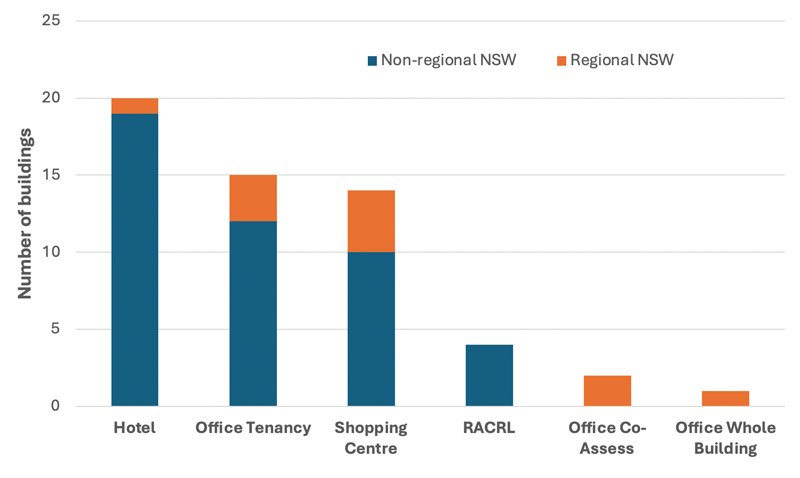
Graph showing the number of buildings taken up by the NSW Energy Starters program
NABERS Perform
Upgrades to the NABERS Perform platform this year continue to enhance usability and improve the accuracy of ratings calculations.
NABERS Perform platform is the result of extensive collaboration with NABERS Assessors and customers, who helped shape our vision for a streamlined, user-friendly experience that supports building owners to achieve their sustainability goals. Launched with funding support from the Australian Government, NABERS Perform is one of the most significant advancements since the program’s inception and underscores technology's critical role in accelerating the transition to net zero.
Among the new features is the ability to simultaneously lodge and certify a portfolio of thousands of ratings to support NABERS Energy and Water for Schools. We’ve also enabled Assessor and customer account management processes to be managed within NABERS Perform to reduce administration. And a digitised version of the Assessor supervision process allows Assessors to lodge their supervised ratings quicker, so they can spend more time doing what they do best – elevating sustainability in the built environment.
Climate Active Carbon Neutral certification
NABERS began offering a pathway to achieve Climate Active Carbon Neutral certification for office buildings (whole buildings and base buildings), shopping centres in 2019 and hotels in 2021. This year, certification expanded to warehouses and cold stores, and data centres. This will ensure more building owners can use the combination of NABERS Energy and Climate Active certification in their annual reporting and emissions reduction strategies.
NABERS Waste
Interest in the verification method for waste has grown over the last financial year, and 16 properties have been verified. This is a 700% increase year-on-year. Work also commenced on the Waste Strategic Roadmap with the aim of aligning waste outreach activities with the new NABERS 2024-2029 Strategic Plan.
Policy and Partnerships: Advancing sustainable buildings policy
As policy evolves, NABERS continues to engage with stakeholders to advance sustainable building practices, inform new regulations and drive progress towards net zero emissions and a circular economy.
NABERS Policy Toolkit
Following significant consultation with stakeholders, we developed the NABERS Policy Toolkit to help policymakers achieve stronger environmental outcomes in Australia's buildings. The toolkit details how NABERS can be effectively integrated into policy making to drive progress towards net zero emissions and a circular economy and explores a range of strategies, including ratings disclosure, establishing minimum thresholds, and implementing progressive building upgrades over time.
NSW Sustainable Building SEPP
The NSW Government’s State Environmental Planning Policy (Sustainable Buildings) 2022, known as the Sustainable Buildings SEPP, came into effect in October 2023. The policy encourages the design and construction of more sustainable buildings and lays a solid foundation for national embodied emissions reporting and action through NABERS. Large commercial developments are now required to sign a NABERS Commitment Agreement or an Agreement to Rate to comply with the policy’s energy and water standards.
This year, the NABERS team collaborated with the NSW Government to develop a fact sheet that articulates the impact of the Sustainable Buildings SEPP. The NSW Government estimates that the non-residential requirements alone will abate more than 700,000 tonnes of emissions from lower energy consumption and offsetting.
Federal Net Zero in Government Operations Strategy
In November 2023, the Australian Government Department of Finance released its Net Zero in Government Operations Strategy. This increases the minimum NABERS Energy ratings leased by Commonwealth entities to 5.5 stars and includes provisions to consider NABERS ratings for warehouses and hotels used by Commonwealth employees.
This strategy is “genuinely groundbreaking”, Carlos Flores told The Fifth Estate and will “drive decarbonisation through the billions of dollars of private sector services” procured by the Australian Government.
In May 2023, the Digital Transformation Agency launched a new Data Centre Panel with stricter requirements for managing and reducing greenhouse gas emissions. All providers must hold a 5-star NABERS Energy rating or equivalent to join. From 1 July 2025, new Commonwealth-owned or leased data centres outside the Panel must also achieve and maintain a 5-star rating or equivalent.
National Construction Code update
NABERS provided feedback on the draft version of the National Construction Code 2025 (NCC 2025) from the Australian Building Codes Board. In this feedback, NABERS suggested updates to the J1V1 verification method, which is used to assess energy efficiency in commercial buildings. Our submission proposes to revise the target ratings in NABERS Energy Commitment Agreements to reflect the higher standards of NCC 2025 and to adjust NABERS Energy star ratings to align with the NCC's new modelling requirements.
NABERS International: Expanding global partnerships
NABERS has made significant strides globally, with a new UK administrator, growth in New Zealand and a successful pilot in Germany.
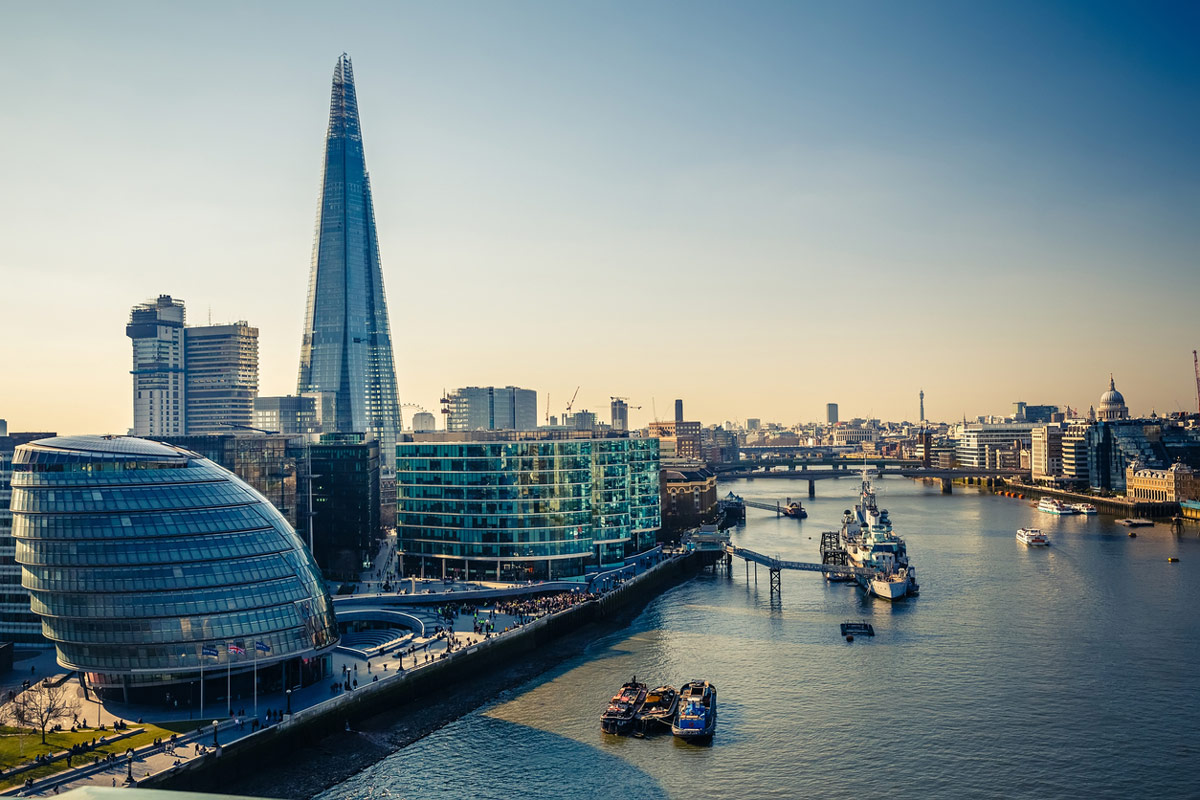
Image: London, Uniting Kingdom, CIBSE commences as new UK administrator from 1 July 2024
NABERS UK
In September 2023, the Building Research Establishment (BRE) stepped down as NABERS UK administrator. After an extensive Expression of Interest process, NABERS appointed the Chartered Institution of Building Services Engineers (CIBSE) as the new NABERS UK scheme administrator. CIBSE is one of the most influential professional bodies in the UK building sector, with a rich history of leadership in energy efficiency and decarbonisation. NABERS worked closely with BRE and CIBSE to ensure a smooth transition, and NABERS UK officially began its new era with CIBSE on 1 July 2024.
New Zealand

Image: NABERS Magali Wardle presenting at the Green Property Summit in New Zealand
NABERSNZ has seen strong growth, with a 16% year-in-year increase in Energy for Offices ratings in FY24. Ratings for New Zealand’s public hospitals have now commenced, and the Energy Efficiency and Conservation Authority (EECA) expects to see the first NABERS Energy and Water ratings for Public Hospitals certified later this year.
Germany
In November 2023, we conducted a pilot of NABERS Energy for Offices in partnership with DENEFF, a network of German companies that promote energy efficiency. Five office buildings were rated by an Australian Assessor, confirming the viability of NABERS in Germany. This work follows the launch of the Global Guide to NABERS Energy Efficiency in Commercial Buildings, launched in 2022, led by the Australia-Germany Energy Working Group.
Marketing, Events and Training: Ongoing industry conversations
Our largest ever conference, a strong digital presence, and well-attended online industry events are just three ways we engaged in industry conversations and expanded NABERS’ reach in FY24.
We employ integrated campaigns that include electronic direct mail, social media, events and website updates to communicate and engage with our audiences.
This financial year, NABERS reached 12,000 followers through LinkedIn, and we continue to embrace new channels to engage deep and wide industry conversations.
NABERS launched a promotional campaign to boost awareness and drive registrations for the NABERS + CBD Conference. To maximise and manage registrations, we created a unique event brand, developed a dedicated website to engaged participants, and implemented a targeted outreach strategy across all sectors.
When 700 attendees gathered for the largest NABERS + CBD Conference in our history, this marked a milestone in our commitment to industry dialogue.

Image: NABERS + CBD Conference website landing page
Just some of the words of praise from our stakeholders confirm that our partnership approach to marketing and communications is delivering dividends:
- “We are lucky to have programs like NABERS – because it takes us further and faster together.” Davina Rooney, Chief Executive Officer, Green Building Council of Australia
- “NABERS for us is not just a baseline for performance. It's a good communicator for our investors and tenants. We use it actively with our centre managers and operations managers to look at how we improve the performance of our buildings.” Jo-Ann Gamble, General Manager, Sustainability Investment Management, Lendlease
- “NABERS ratings have a great opportunity in hotels… We are finding the star rating is not as important as the NABERS process itself.” Diana Rico-Roa, Director, ESG Plus
Key highlights:
- 700-plus attendees at the NABERS + CBD Conference
- 40 industry conferences and events featured NABERS staff presentations
- 12,000 LinkedIn followers, an increase of 4,000 in FY24
- 97,000 people engaged through direct email campaigns
- 450 people engaged through online events on hotels, materials recovery, data centres, warehouse and cold stores, energy simulation and funding opportunities.
- 1,200 people engaged through industry expos: Whole of Government Travel Exhibition in Canberra, NoVacancy Hotel and Accommodation expo in Sydney and National Retirement Living Summit in the Gold Coast.

Image: NABERS’ expo at the Whole of Australian Government Travel Exhibition October 2023

Image: NABERS Director Carlos Flores presenting at an industry events

Image: NABERS staff share information at the NABERS + CBD Conference booth
Training in new tools
The release of several new rating tools has kept the NABERS training team busy. More than 90 Assessors have been accredited since we launched NABERS Energy and Water for Schools and held our first webinar in January 2024. Similarly, more than 70 Assessors have been accredited to support NABERS Energy for Retail Stores.
This year, we’ve also welcomed 77 trainees to join our community as newly-accredited Assessors.
Aside from rolling out webinars for our new tools, our most popular accreditation course enrolments were for Energy and Water for Offices, Waste for Offices and Carbon Neutral. And our training team continues to evolve our feedback process to ensure trainees continue to improve and build confidence.
Operations: Focused on the future
Our growing team is focused on projects that further our three goals to improve performance, grow the market and evolve for impact.
Operational review project
Our strategic plan forecasts NABERS ratings to increase up to three times by 2030. To accommodate this growth, we need to make ambitious changes to our operations and to Assessors’ processes. We’ve pinpointed key priorities, and in FY25 and beyond we have plans to:
- Update our rules to accelerate data collection for Assessors. This will include introducing virtual site visits for shopping centres, clarifying the criteria for atypical shopping centres and incorporating serviced apartments as a typical hotel rating.
- Enhance our query handling to deliver faster, more precise answers to Assessors. This includes gathering more information from our stakeholders upfront and changing how our tech team answers queries and shares information. Optimise our auditing procedures to focus on what truly matters.
- Collaborate closely with the NABERS Perform team to advance our technology to support our goals.
Key highlights:
- 5,000 ratings certified in FY24, with 97% achieved within 10 days of submission
- 166 audits undertaken, achieving our L2 audit target of 5%
- 11,500 cases closed
- 58 Assessors onboarded.
Team update
As NABERS expands its influence and impact, our team grows too. This financial year NABERS has grown its headcount by 26%. This follows on from a 38% increase in headcount the previous year. With our fit-for-future structure, we are excited to be working alongside our stakeholders to build a more sustainable tomorrow.
In FY23/24, NABERS staff held two team building days focused on networking, collaboration and strategic planning. The first event, in October 2023, focused on the NABERS Strategic Plan and the Operational Review Project, alongside engaging team-building exercises. The second event, in April 2024, celebrated key achievements and set future priorities, while continuing discussions on the strategic plan.
With a dedicated team, strong industry partnerships and the support of engaged and visionary government partners, NABERS is poised to realise our vision for sustainable buildings that enable a world where people and the natural environment thrive.

Image: NABERS staff at the NABERS + CBD Conference

Image: NABERS Staff at Branch Day October 2023

Image: NABERS Staff at Branch Day – October 2023

Image: NABERS Perform Team Collaboration Day
